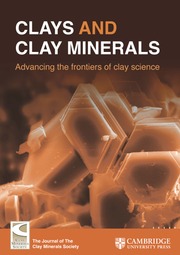Crossref Citations
This article has been cited by the following publications. This list is generated based on data provided by
Crossref.
Salmimies, Riina
Mannila, Marju
Kallas, Juha
and
Häkkinen, Antti
2011.
Acidic Dissolution of Magnetite: Experimental Study on the Effects of Acid Concentration and Temperature.
Clays and Clay Minerals,
Vol. 59,
Issue. 2,
p.
136.
Platova, R. A.
Chernyshov, A. N.
and
Maslennikova, G. N.
2012.
Biotreatment of clayey materials and ceramic pastes: directions, methods and experience (review).
Glass and Ceramics,
Vol. 69,
Issue. 7-8,
p.
229.
Salmimies, Riina
Huhtanen, Mikko
Kallas, Juha
and
Häkkinen, Antti
2013.
The Solubility of Two Magnetite Powders in Oxalic Acid: Applicability of Empirical Modelling.
Journal of Powder Technology,
Vol. 2013,
Issue. ,
p.
1.
Platova, R. A.
Maslennikova, G. N.
and
Platov, Yu. T.
2013.
Biochemical Method of Removing Iron from Zhuravlinyi Log Kaolin.
Glass and Ceramics,
Vol. 70,
Issue. 1-2,
p.
51.
Zegeye, Asfaw
Yahaya, Sani
Fialips, Claire I.
White, Maggie L.
Gray, Neil D.
and
Manning, David A.C.
2013.
Refinement of industrial kaolin by microbial removal of iron-bearing impurities.
Applied Clay Science,
Vol. 86,
Issue. ,
p.
47.
Hosseini, Mohammad Raouf
and
Ahmadi, Ali
2015.
Biological beneficiation of kaolin: A review on iron removal.
Applied Clay Science,
Vol. 107,
Issue. ,
p.
238.
Salmimies, Riina
Vehmaanperä, Paula
and
Häkkinen, Antti
2016.
Acidic dissolution of magnetite in mixtures of oxalic and sulfuric acid.
Hydrometallurgy,
Vol. 163,
Issue. ,
p.
91.
Lu, Mang
Xia, Guanghua
and
Cao, Wen
2017.
Iron removal from kaolin using thiourea dioxide: Effect of ball grinding and mechanism analysis.
Applied Clay Science,
Vol. 143,
Issue. ,
p.
354.
Dousova, Barbora
Lhotka, Miloslav
Filip, Jan
and
Kolousek, David
2018.
Removal of arsenate and antimonate by acid-treated Fe-rich clays.
Journal of Hazardous Materials,
Vol. 357,
Issue. ,
p.
440.
Hajihoseini, Jalal
and
Fakharpour, Mahsa
2019.
Effect of temperature on bioleaching of iron impurities from kaolin byAspergillus nigerfungal.
Journal of Asian Ceramic Societies,
Vol. 7,
Issue. 1,
p.
82.
Saleh, Danyal Karbalaei
Abdollahi, Hadi
Noaparast, Mohammad
Nosratabad, Alireza Fallah
and
Tuovinen, Olli H.
2019.
Dissolution of Al from metakaolin with carboxylic acids produced by Aspergillus niger, Penicillium bilaji, Pseudomonas putida, and Pseudomonas koreensis.
Hydrometallurgy,
Vol. 186,
Issue. ,
p.
235.
Pariyan, K.
Hosseini, M. R.
Ahmadi, A.
and
Zahiri, A.
2020.
Optimization and kinetics of oxalic acid treatment of feldspar for removing the iron oxide impurities.
Separation Science and Technology,
Vol. 55,
Issue. 10,
p.
1871.
Olvera Venegas, Patricia Nayeli
Villanueva Ibáñez, Maricela
Flores González, Marco Antonio
Reyes Aparicio, Ariadna Itzel
and
Hernández Pérez, María de los Ángeles
2020.
Novel alternative for the purification of kaolin by plant acid extracts.
Green Materials,
Vol. 8,
Issue. 2,
p.
92.
Haynes, Haydn M.
Bailey, Matthew T.
and
Lloyd, Jonathan R.
2021.
Bentonite barrier materials and the control of microbial processes: Safety case implications for the geological disposal of radioactive waste.
Chemical Geology,
Vol. 581,
Issue. ,
p.
120353.
Tian, Hongwei
Stephan, Dietmar
Lothenbach, Barbara
and
Lehmann, Christian
2021.
Influence of foreign ions on calcium silicate hydrate under hydrothermal conditions: A review.
Construction and Building Materials,
Vol. 301,
Issue. ,
p.
124071.
Ali, Maaz A.
Ahmed, Hussin A. M.
Ahmed, Haitham M.
and
Hefni, Mohammed
2021.
Pyrophyllite: An Economic Mineral for Different Industrial Applications.
Applied Sciences,
Vol. 11,
Issue. 23,
p.
11357.
Yong, Shih Nee
Lim, Steven
Ho, Chun Loong
Chieng, Sylvia
and
Kuan, Seng How
2022.
Mechanisms of microbial-based iron reduction of clay minerals: Current understanding and latest developments.
Applied Clay Science,
Vol. 228,
Issue. ,
p.
106653.
Vehmaanperä, Paula
Sihvonen, Tuomas
Salmimies, Riina
and
Häkkinen, Antti
2022.
Dissolution of Magnetite and Hematite in Mixtures of Oxalic and Nitric Acid: Mechanisms and Kinetics.
Minerals,
Vol. 12,
Issue. 5,
p.
560.
Li, Jiafeng
Zhang, Haijun
Wang, Haifeng
and
Zhang, Baojing
2023.
Research progress on bioleaching recovery technology of spent lithium-ion batteries.
Environmental Research,
Vol. 238,
Issue. ,
p.
117145.
Oziegbe, O.
Oziegbe, E. J.
and
Ahuekwe, E. F.
2024.
Environmental Significance of Microbe-Clay Interaction: A Mini-Review.
IOP Conference Series: Earth and Environmental Science,
Vol. 1428,
Issue. 1,
p.
012008.

